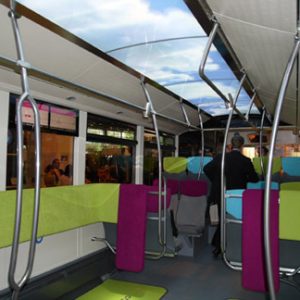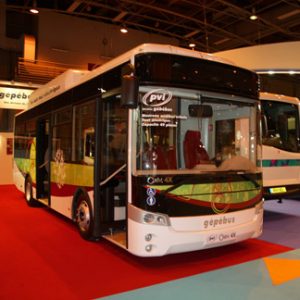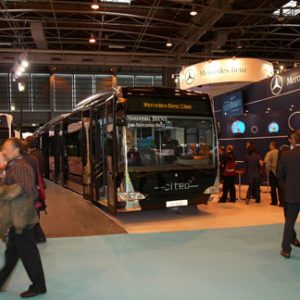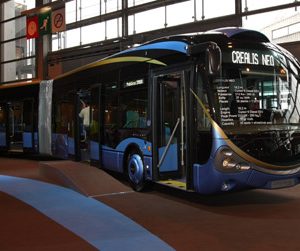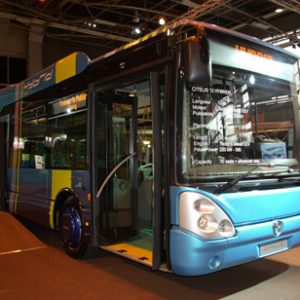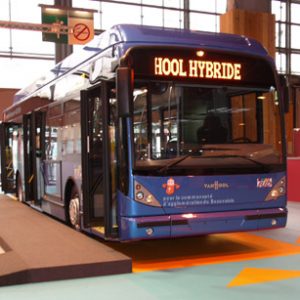By Doug Jack
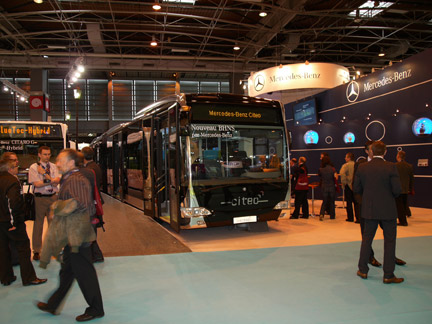
Every two years a public transport exhibition takes place in Paris. In previous years complete trams have been on display, but this year exhibitors keeping an eye on costs occupied only about half the previous floor space. Even so there were many interesting vehicles.
Last year registrations of new buses and coaches in France set an all-time record at more than 6,200 units over 8 tons gross. The government helped to stimulate the market by bringing forward an option of more than 250 buses for RATP, the main operator in the Paris region. The entire fleet is now wheelchair accessible.
Another reason for the strong demand is a law that prohibits carrying school children in vehicles more than 15 years old.
There are no special school buses. There is a requirement for multi-purpose coaches from 37 to 43 feet in length to carry children during the week and for local excursions and charter on weekends. France has built tramways in several cities, but there was a general feeling that such expensive projects are no longer affordable as they only serve a small proportion of the population regardless of their location. For the cost of one tram system and the infrastructure, a typical city could replace its entire fleet of buses with new vehicles to serve the total population.
France has embraced the idea of Bus Rapid Transit, known in that country as BHNS, which roughly translates Bus at High Level of Service. This is actually a very good description of the concept. A number of cities operate BHNS systems that enjoy the benefit of exclusive bus lanes. Both Mercedes-Benz and Irisbus were hoping with less public money available, BHNS systems might be installed in place of tramways.
Based on standard articulated buses with diesel or CNG-fuelled engines, they feature some modification to the external styling and substantially different interior layouts.
Four years ago at the same exhibition, the Irisbus subsidiary of Iveco showed the Crealis with its very trendy interior with bright and welcoming colors and wooden plank flooring. The seats were arranged club style, and the limited standing areas offer padded sidewalls to support the lower back. The whole effect was quite different from a typical transit bus with its rows of forward facing seats.
This year, Irisbus took this one stage further, launching the Crealis Neo with a slightly longer front overhang and a large sloping one-piece windshield. The design intentionally looks like a tram, but under the skin it is a standard bus. More than 80 of these vehicles are now in service or on order with options.
Mercedes-Benz has built more than 25,000 units in its Citaro city bus family. I use the word family deliberately because it is available up to the four axle CapaCity model with right and left hand drive and in various lengths both rigid and articulated with full low floor or low entry.
In Paris the company showed a Citaro Citeo with slightly modified external skin panels and a completely different interior. The illumination from the three-foot wide full length roof panel emanates through a cover that looks like a powder-blue sky with wispy clouds. Customers can select the theme much like they choose from available screen savers for their computers.
Some seats are in fixed locations, such as over the wheelboxes, while others more randomly located lend a club-like feeling to the interior. It has the appearance and informality of a party where the host has to find extra seats from around the house.
Every time I looked at the bus people were standing inside chatting, even though there were tables and chairs available outside in the Mercedes-Benz hospitality area.
Irisbus and its French subsidiary, Heuliez Bus, launched hybrid vehicles using the BAE Systems hybrid drive. In a press conference the company justified its selection of the BAE equipment by referring to its widespread use in North America, and also the very successful experience in London. Irisbus will continue developing the hydraulic hybrid vehicle, first seen in concept form two years ago, and that will go into volume production after the BAE hybrids.
Van Hool has built and already delivered hybrid buses in mid-size, full size and articulated versions, all with the thermal engine and drive system mounted on the offside between the first and second axles. For the first time, the company has built a diesel hybrid bus with the engine and Siemens hybrid drive system mounted behind the rear axle and offset to the same side as the driver, enabling the fitment of three double width doors. The A330 hybrid was destined for Beauvais, a town north of Paris.
Whereas the Irisbus vehicles stores electrical energy in lithium-ion batteries, Van Hool opted for ultra capacitors mounted at roof level.
PVI is a French company that once built complete commercial vehicles under its previous name, Ponticelli. It now specializes in converting trucks, mainly Renault, for municipal operation with gas engines and all electric drive systems.
The company showed a neat little minibus, also a larger midi bus built in collaboration with Otokar of Turkey. The latter builds the complete structure, including the interior. PVI installs an electric motor and the lithium-ion batteries.
Known as the Oreos 4X, it has a range of about 80 miles on a full charge but the batteries can be boosted when the bus stops at terminals, which extends its range.
France produces much of its electricity from nuclear power, therefore the vehicle could claim to have zero emissions.
PVI said that there is interest in the concept, not only for short routes in city centers, but also from airports that use small buses more intermittently.
Solaris, the enterprising Polish builder, extended its range last year with an interurban coach, another hybrid bus but with the Eaton system and the Tramino, a full low floor, five-section tram.
Many cities in Central and Eastern Europe have large tram systems, going back to Soviet times. There is an urgent need to replace old rolling stock, going back to that era. But money is tight and it will take time.
Solaris had a record year in 2009 and said that it was even busier this year. It was able to respond quickly to large orders from Norway and Sweden for buses fueled by compressed natural gas and by biogass. The company has been the largest importer of city buses to the competitive German market for several years and has set its sights on expansion in France and Italy.
France is a market that expects and demands quality, and Transports Publics has its own unique atmosphere. Fortunately the days have gone when the air was hazy with cigarette smoke, but there was plenty of fine wine and delicious snacks for those who wanted to conduct business in a friendly and relaxed manner. France may have its difficulties, but I can strongly recommend the 2009 Bordeaux when it crosses the pond.
Doug Jack is with Transport Resources in the United Kingdom.

